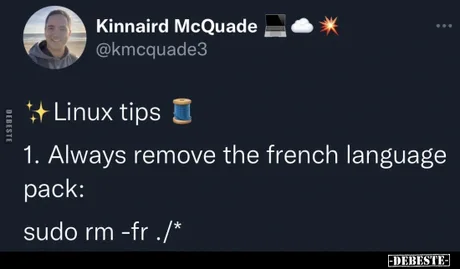this post was submitted on 12 Nov 2024
776 points (91.4% liked)
linuxmemes
24655 readers
1764 users here now
Hint: :q!
Sister communities:
Community rules (click to expand)
1. Follow the site-wide rules
- Instance-wide TOS: https://legal.lemmy.world/tos/
- Lemmy code of conduct: https://join-lemmy.org/docs/code_of_conduct.html
2. Be civil
- Understand the difference between a joke and an insult.
- Do not harrass or attack users for any reason. This includes using blanket terms, like "every user of thing".
- Don't get baited into back-and-forth insults. We are not animals.
- Leave remarks of "peasantry" to the PCMR community. If you dislike an OS/service/application, attack the thing you dislike, not the individuals who use it. Some people may not have a choice.
- Bigotry will not be tolerated.
3. Post Linux-related content
- Including Unix and BSD.
- Non-Linux content is acceptable as long as it makes a reference to Linux. For example, the poorly made mockery of
sudoin Windows. - No porn, no politics, no trolling or ragebaiting.
4. No recent reposts
- Everybody uses Arch btw, can't quit Vim, <loves/tolerates/hates> systemd, and wants to interject for a moment. You can stop now.
5. 🇬🇧 Language/язык/Sprache
- This is primarily an English-speaking community. 🇬🇧🇦🇺🇺🇸
- Comments written in other languages are allowed.
- The substance of a post should be comprehensible for people who only speak English.
- Titles and post bodies written in other languages will be allowed, but only as long as the above rule is observed.
6. (NEW!) Regarding public figures
We all have our opinions, and certain public figures can be divisive. Keep in mind that this is a community for memes and light-hearted fun, not for airing grievances or leveling accusations. - Keep discussions polite and free of disparagement.
- We are never in possession of all of the facts. Defamatory comments will not be tolerated.
- Discussions that get too heated will be locked and offending comments removed.
Please report posts and comments that break these rules!
Important: never execute code or follow advice that you don't understand or can't verify, especially here. The word of the day is credibility. This is a meme community -- even the most helpful comments might just be shitposts that can damage your system. Be aware, be smart, don't remove France.
founded 2 years ago
MODERATORS
you are viewing a single comment's thread
view the rest of the comments
view the rest of the comments

My filesystem is btrfs and I've got timeshift setup, how hard will this fuck me, if at all? Is there anyway I can be fucked harder? (Asking for a friend)
WARNING:
Don't ever do this on a current bare metal system!
Even if you have everything backed up, plan on re-installing anyway, and just want to see what happens.
On a modern EFI system, recursively deleting everything (including the EFI path) has a chance of permanently hard-bricking your computer!
https://github.com/systemd/systemd/issues/2402
Depends, are you backing up to another partition or drive?
If not, you're pretty fucked.
Aren’t snapshots in btrfs above root?
Edit: they are in “subvolumes”
Source: ChatGPT
On a Btrfs filesystem, running rm -rf /* will attempt to delete everything in the root directory, which includes all files and directories accessible to your permissions. However, Btrfs snapshots are designed to be resistant to regular file deletion commands. Here’s what happens:
1. Snapshots remain intact: rm -rf /* doesn’t automatically delete snapshots because snapshots are stored in special subvolumes. By default, this command won’t affect subvolumes that are not mounted within the filesystem you’re deleting from.
2. You would need specific commands to delete snapshots: To delete snapshots on Btrfs, you would typically use a command like btrfs subvolume delete <snapshot> for each snapshot individually, as snapshots are managed by the filesystem and not treated as standard directories.
3. The data inside the snapshots is preserved: Even if files in the root filesystem are deleted, any data captured in snapshots remains, as snapshots are essentially read-only copies at a certain point in time.
Important Note: If the snapshots are mounted and accessible in the directory tree where rm -rf /* is run, you could accidentally delete them if the command traverses into the snapshots’ directories. To protect snapshots, administrators often mount them in isolated directories (e.g., /snapshots) or keep them unmounted until explicitly needed.
In summary, unless you run specific deletion commands for Btrfs subvolumes, snapshots should remain unaffected by rm -rf /* due to the unique way Btrfs manages snapshots.
Oh shit